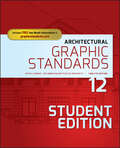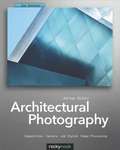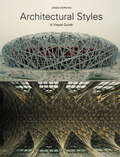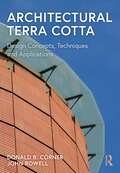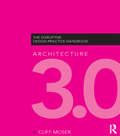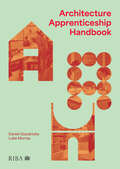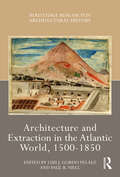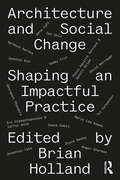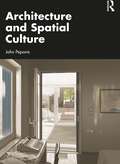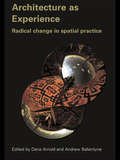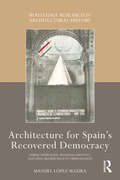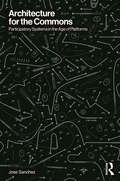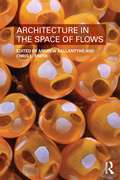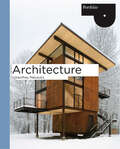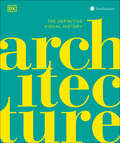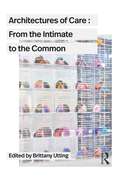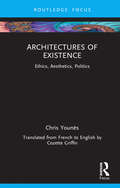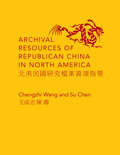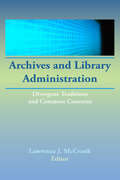- Table View
- List View
Architectural Graphic Standards: Student Edition (Ramsey/Sleeper Architectural Graphic Standards Series #25)
by American Institute of Architects Keith E. HedgesARCHITECTURAL GRAPHIC STANDARDS THE LANDMARK UPDATE OF THE MOST RECOGNIZED STUDENT RESOURCE IN ARCHITECTURE The Student Edition of the iconic Architectural Graphic Standards has been a rite of passage for architecture, building, and engineering students for more than eighty years. Thoughtfully distilled from the Twelfth Edition of Architectural Graphic Standards and reorganized to meet the specific needs of today’s students, this fully updated Student Edition shows you how to take a design idea through the entire planning and documentation process. This potent resource stays with you through your academic experience and into your first years as a professional with thousands of useful illustrations and hundreds of architectural elements conveniently placed at your fingertips. Presented in a format closely resembling an architect’s actual workflow, this Twelfth Edition student handbook features: Completely new material on resiliency in buildings A versatile treatment written for the design studio setting and aligned with the most current curricular trends, including new and updated coverage on topics related to sustainability, digital fabrication, and building information modeling (BIM) A proven pedagogy that saves students time and ensures young professionals avoid the most common pitfalls Develop a state-of-the-art mastery of design best practices with Architectural Graphic Standards, Twelfth Edition, Student Edition.
Architectural Photography
by Adrian SchulzArchitectural photography is more than simply choosing a subject and pressing the shutter-release button; it's more than just documenting a project. An architectural photograph shows the form and appeal of a building far better than any other medium. With the advent of the digital photographic workflow, architects are discovering exciting new opportunities to present and market their work. But what are the ingredients for a successful architectural photograph? What equipment do you need? How can you improve your images in your digital darkroom? Why does a building look different in reality than in a photographic image? In this book you will find the answers to these questions and much more. Author Adrian Schulz-both an architect and a photographer by training-uses real-world projects to teach you how to: Capture outstanding images of buildings, inside and out Choose the right equipment and use it effectively Compose architectural shots Work with ambient and artificial light Process images in an efficient workflow based on Adobe Photoshop This book is a step-by-step guide to architectural photography for both the aspiring amateur photographer interested in architectural photography and the professional photographer wanting to expand his skills in this domain. Moreover, architects themselves will find this book motivating and inspiring. This second edition has been extensively revised and includes 80 new images and illustrations, as well as an expanded chapter on shooting interior spaces. Also included is an updated discussion of post-processing techniques and the latest technical developments in the world of photography. With this book, you will learn a variety of creative tips, tricks, and guidelines for making the perfect architectural image.
Architectural Styles: A Visual Guide
by Owen HopkinsHave you ever wondered what the difference is between Gothic and Gothic Revival, or how to distinguish between Baroque and Neoclassical? This guide makes extensive use of photographs to identify and explain the characteristic features of nearly 300 buildings. The result is a clear and easy-to-navigate guide to identifying the key styles of western architecture from the classical age to the present day.
Architectural Styles: A Visual Guide
by Owen HopkinsHave you ever wondered what the difference is between Gothic and Gothic Revival, or how to distinguish between Baroque and Neoclassical? This guide makes extensive use of photographs to identify and explain the characteristic features of nearly 300 buildings. The result is a clear and easy-to-navigate guide to identifying the key styles of western architecture from the classical age to the present day.
Architectural Technicities: A Foray Into Larval Space (Architectural Borders and Territories)
by Stavros KousoulasThis book poses a simple question: how is this architecture possible? To respond, it will embark on a captivating journey through many singular architectural concepts. The entasis of Doric columns, Ulysses and desert islands will outline an architectural act that moves beyond representation. A ferryman who stutters will present two different types of architectural minds. A stilus and a theory of signs will reconsider the ways architects can develop a particular kind of intuition, while architectural technicities will bring forth a membranic and territorial understanding of architecture. Finally, as a melody that sings itself, a larval architecture will be introduced, bringing space and time together. Assisting this endeavour, the thought of philosophers like Gilles Deleuze, Felix Guattari, Gilbert Simondon and Raymond Ruyer will meet the latest developments in fields like affect theory, cognitive sciences, environmental studies and neuroanthropology. Eventually, by the end of this book, the readers – from architecture students and researchers to academics and practitioners with an interest in theory – will have been exposed to a comprehensive and original philosophy of architecture and the built environment.
Architectural Terra Cotta: Design Concepts, Techniques and Applications
by John Rowell Donald B. CornerArchitectural Terra Cotta examines the evolution of terra cotta and prepares architects and builders to make new, creative uses of the timeless material. Terra cotta is among the oldest of manufactured building products, yet it has once again become a material of choice in contemporary façade design. From the walls of Babylon to high performance rainscreens, terra cotta claddings have repeatedly proven to be technically superior and aesthetically triumphant. Understanding the evolution of terra cotta prepares architects to add new, creative chapters to a rich history. This book describes the key attributes that recommend the use of terra cotta and explain its continuing success. The core of the book traces the many ways that terra cotta can be formed, finished and applied to buildings. These techniques demonstrate the full potential of the material, showing how its unique capabilities have been developed over time. A comprehensive inventory of recent examples, project case studies and architectural details, this book provide a basis for understanding the nature of the material and the opportunities it offers in new work. With over 150 color images, this volume provides a concise resource for all those considering terra cotta as a façade system: architects, façade engineers, cladding subcontractors, materials suppliers, developers and prospective clients. With inspiring examples of expressive possibility, this invaluable book will find a home with students and professionals alike interested in making rich, colorful and durable buildings.
Architecture 101
by Nicole BridgeA crash course in designing and constructing buildingsToo often, textbooks turn the noteworthy details of architecture into tedious discourse that would put even Frank Gehry to sleep. Architecture 101 cuts out the boring explanations, and instead provides a hands-on lesson that keeps you engaged as you explore the world's greatest structures.Featuring only the most important facts, building styles, and architects, you'll enjoy uncovering the remarkable world of architecture with this book. Inside, you'll also find fascinating elements like:Illustrations of popular building styles, such as Georgian and Greek RevivalDrawings of the essential parts of different buildingsUnique profiles of the most inspirational figures in architectureFrom Norman Foster and Frank Lloyd Wright to the Beauvais Cathedral and the Empire State Building, Architecture 101 is packed with hundreds of entertaining architecture tidbits that you can't get anywhere else!
Architecture 101: From Frank Gehry to Ziggurats, an Essential Guide to Building Styles and Materials
by Nicole BridgeA crash course in designing and constructing buildingsToo often, textbooks turn the noteworthy details of architecture into tedious discourse that would put even Frank Gehry to sleep. Architecture 101 cuts out the boring explanations, and instead provides a hands-on lesson that keeps you engaged as you explore the world's greatest structures.Featuring only the most important facts, building styles, and architects, you'll enjoy uncovering the remarkable world of architecture with this book. Inside, you'll also find fascinating elements like:Illustrations of popular building styles, such as Georgian and Greek RevivalDrawings of the essential parts of different buildingsUnique profiles of the most inspirational figures in architectureFrom Norman Foster and Frank Lloyd Wright to the Beauvais Cathedral and the Empire State Building, Architecture 101 is packed with hundreds of entertaining architecture tidbits that you can't get anywhere else!
Architecture 3.0: The Disruptive Design Practice Handbook
by Cliff MoserThis book provides a definitive guide for the future direction of the practice and profession of architecture. In five parts, Cliff Moser provides you with all the tools and know-how to implement changes that will serve you and your practice in the short, medium and long term. Written at a crucial time for the industry, this is essential reading for every architect.
Architecture Apprenticeship Handbook
by Daniel Goodricke Luke MurrayArchitecture apprenticeships are a new route into the profession. Having gained traction since their inception in 2018, it is an attractive route for young generations of architects to obtain their professional qualifications and earn while they learn. Aimed at prospective and current Level 7: Architect Apprentices, this guide provides the knowledge to achieve the most from your apprenticeship education, empowering your exposure in the profession within academic and professional areas. Taking you on a journey through the apprenticeship, it presents key stages of the course through precedents and will let you know what to expect from this educational route, and when to expect it. Using case studies from recent graduates and current apprentices who have excelled through this route, it features information from employers and academics involved in architecture apprenticeship courses in the UK to provide tips, advice and guidance. Designed to be interactive, you will be able to populate and annotate the book at various stages to map the key stages of your journey and reflect on your professional development.
Architecture and Extraction in the Atlantic World, 1500-1850 (Routledge Research in Architectural History)
by Luis Gordo Peláez Paul NiellThis edited collection examines the development of Atlantic World architecture after 1492. In particular, the chapters explore the landscapes of extraction as material networks that brought people, space, and labor together in harvesting raw materials, cultivating agriculture for export-level profits, and circulating raw materials and commodities in Europe, Africa, and the Americas from 1500 to 1850. This book argues that histories of extraction remain incomplete without careful attention to the social, physical, and mental nexus that is architecture, just as architecture’s development in the last 500 years cannot be adequately comprehended without attention to empire, extraction, colonialism, and the rise of what Immanuel Wallerstein has called the world system. This world system was possible because of built environments that enabled resource extraction, transport of raw materials, circulation of commodities, and enactment of power relations in the struggle between capital and labor. Separated into three sections: Harvesting the Environment, Cultivating Profit, and Circulating Commodities: Networks and Infrastructures, this volume covers a wide range of geographies, from England to South America, from Africa to South Carolina. The book aims to decenter Eurocentric approaches to architectural history to expose the global circulation of ideas, things, commodities, and people that constituted the architecture of extraction in the Atlantic World. In focusing on extraction, we aim to recover histories of labor exploitation and racialized oppression of interest to the global community. The book will be of interest to researchers and students of architectural history, geography, urban and labor history, literary studies, historic preservation, and colonial studies.
Architecture and Social Change: Shaping an Impactful Practice
by Brian HollandArchitecture and Social Change is a timely, and urgently needed, survey of social and environmental justice advocacy in architecture. Spotlighting contemporary design and research practitioners who are creatively leveraging their expertise for social change, this book features interviews with fifteen influential design leaders who are at the forefront of their profession’s efforts to confront pressing challenges like housing insecurity, racial and economic inequality, environmental degradation, and architectural waste. Among the interviewees are Dana Cuff, who, as director of cityLAB, is helping to reshape housing policy in California; Joana Dabaj, cofounder of the design charity CatalyticAction, which empowers refugee children from the Syrian civil war to act as “co-designers” of playgrounds and public spaces in Lebanon; and Ivi Diamantopoulou and Jaffer Kolb of New York City–based New Affiliates, who repurpose, through lively recontextualization, the architectural byproducts of their city’s museum exhibitions and building-performance mockups. These insightful student-led interviews compellingly capture the current moment of soul-searching in both the profession and the academy.An indispensable guide for design students and professionals alike, Architecture and Social Change gathers inspirational stories alongside practical advice for how to navigate a career in architecture while seeking to make a positive impact.
Architecture and Spatial Culture
by John PeponisBuilt space supports our daily habits and our membership of communities, organizations, institutions, or social formations. Architecture and Spatial Culture argues that architecture matters because it makes the settings of our life intelligible, so that we can sustain or creatively transform them.As technological and social innovations allow us to overcome spatial constraints to communication, cooperation, and exchange, so the architecture of embodied experience reflects independent cultural choices and human values. The analysis of a wealth of examples, from urban environments to workplaces and museums, shows that built space functions pedagogically, inducing us to specific ways of seeing, understanding, and feeling, and supporting distinct patterns of cooperation and life in common.Architecture and Spatial Culture is about the principles that underpin the design and inhabitation of space. It also serves as an introduction to Space Syntax, a descriptive theory used to model the human functions of layouts. Thus, it addresses architects, students of architecture and all those working in disciplines that engage the design of the built environment and its social effects.
Architecture as Experience: Radical Change in Spatial Practice
by Dana Arnold Andrew BallantyneArchitecture as Experience investigates the perception and appropriation of places across intervals of time and culture. The particular concern of the volume is to bring together fresh empirical research and animate it through contact with theoretical sophistication, without overwhelming the material. The chapters establish the continuity of a particular physical object and show it in at least two alternative historical perspectives, in which recognisable features are shown in different lights. The results are often surprising, inverting the common idea of a historic place as having an enduring meaning. This book shows the insight that can be gained from learning about earlier constructions of meaning which have been derived from the same buildings that stand before us today.
Architecture for Spain's Recovered Democracy: Public Patronage, Regional Identity, and Civic Significance in 1980s Valencia (Routledge Research in Architectural History)
by Manuel López SeguraHistorical studies on the involvement of architecture in twentieth-century politics have overlooked its contribution to building Spain’s democracy. This pioneering book seeks to fill that void. Between the late 1970s and early 1990s, Spain founded representative institutions, launched its welfare state, and devolved autonomy to its regions. The study brings forth the architectural incarnation of that threefold program as it deployed in the Valencian Country, a Catalan-speaking region on Spain’s Mediterranean shores. There, social democratic authorities mobilized architects, planners, and graphic artists to devise a newly open public sphere and to recover a local identity that Franco’s dictatorship had repressed for decades. The research follows the impetus of reform and its contradictions through urban projects, designs for cultural amenities, and the renovation of governmental and professional bodies. Architecture for Spain’s Recovered Democracy contributes to current debates on nationalism and the arts, the environments of democratic socialism, and postmodernism and neoliberalism. As a result, it widens our understanding of how peripheral regions may yield egalitarian architectures of resistance. This book is written for students and researchers in architecture and planning, art history, spatial politics, and Hispanic studies, as well as for a general readership interested in inclusive politics in the built environment.
Architecture for the Commons: Participatory Systems in the Age of Platforms
by Jose SanchezArchitecture for the Commons dives into an analysis of how the tectonics of a building is fundamentally linked to the economic organizations that allow them to exist. By tracing the origins and promises of current technological practices in design, the book provides an alternative path, one that reconsiders the means of achieving complexity through combinatorial strategies. This move requires reconsidering serial production with crowdsourcing and user content in mind. The ideas presented will be explored through the design research developed within Plethora Project, a design practice that explores the use of video game interfaces as a mechanism for participation and user design. The research work presented throughout the book seeks to align with a larger project that is currently taking place in many different fields: The Construction of the Commons. By developing both the ideological and physical infrastructure, the project of the Commons has become an antidote to current economic practices that perpetuate inequality. The mechanisms of the production and governance of the Commons are discussed, inviting the reader to get involved and participate in the discussion. The current political and economic landscape calls for a reformulation of our current economic practices and alternative value systems that challenge the current market monopolies. This book will be of great interest not only to architects and designers studying the impact of digital technologies in the field of design but also to researchers studying novel techniques for social participation and cooperating of communities through digital networks. The book connects principles of architecture, economics and social sciences to provide alternatives to the current production trends.
Architecture in the Space of Flows
by Chris L. Smith Andrew BallantyneTraditionally, architecture has been preoccupied with the resolution of form. That concern helps to make photogenic buildings, which have received a great deal of attention. This book looks instead at the idea of the flows, which connects things together and moves between things. It is more difficult to discuss, but more necessary, because it is what makes things work. Architects have to think about flow – the flow of people through buildings, the flow of energy into buildings, and waste out of them – but usually the effects of flow do not find expression. The essays gathered here present a collection of exploratory ideas and offer an understanding of buildings, people and settlements through concepts of flow.
Architecture: An Introduction (Portfolio)
by Geoffrey MakstutisThis book offers a thorough introduction to the entire field of architecture, outlining the steps that are normally taken in becoming a qualified architect, from initial education right through to professional practice, as well as how to apply this architectural training in other fields. Complete with feature spreads on individual projects, Architecture: An Introduction's broad, up-to-date approach unites history, theory and practice. Subjects covered include how to develop a brief with a client; taking an idea from brief to project; types of visual presentation including drawings, models and computer renderings; project planning and management; the diverse roles within a company; and the future of architectural practice. This book is a must for anyone considering taking an architecture course or just beginning one.
Architecture: The Definitive Visual Guide (DK Definitive Cultural Histories)
by DKFrom ancient dwellings to modern high-tech skyscrapers, discover everything there is to know about the history of architecture worldwide.Covering over 6,000 years of human history, Architecture charts the most important developments in building materials, technology, design, and the social changes that have shaped the architectural landscape. Explore every significant architectural period and style in depth through critical examples. Take a tour of some of the world&’s most iconic buildings, beautifully illustrated with brilliant photography and specially commissioned CGI artworks. Dive deep into the pages of this inspiring architecture book to discover:- An innovative approach to the story of architecture using iconic examples. - Explores buildings throughout history and across the world.- A combination of creative photography and specially commissioned CGI artworks to analyze every significant architectural style.- Profiles of the latest developments in architectural practice, including &“green&” technology, such as living façades.- Published in association with the Smithsonian Institution in the US.- Optional 56-page reference section profiles key architects and contains profiles of additional important buildings.Find out why so many ancient Roman structures have withstood the test of time. Learn how the soaring ceilings of Gothic cathedrals are held up. And discover the architectural innovations that are helping to combat climate change. Architecture is the perfect book for anyone fascinated by the built world – its visual character and the factors that have formed it – and who wants to understand more.
Architectures of Care: From the Intimate to the Common
by Brittany UttingDrawing from a diverse range of interdisciplinary voices, this book explores how spaces of care shape our affective, material, and social forms, from the most intimate scale of the body to our planetary commons. Typical definitions of care center around the maintenance of a livable life, encompassing everything from shelter and welfare to health and safety. Architecture plays a fundamental role in these definitions, inscribed in institutional archetypes such as the home, the hospital, the school, and the nursery. However, these spaces often structure modes of care that prescribe gender roles, bodily norms, and labor practices. How can architecture instead engage with an expanded definition of care that questions such roles and norms, producing more hybrid entanglements between our bodies, our collective lives, and our environments? Chapters in this book explore issues ranging from disabled domesticities and nursing, unbuilding whiteness in the built environment, practices and pedagogies of environmental care, and the solidarity networks within ‘The Cloud’. Case studies include Floating University Berlin, commoning initiatives by the Black Panther party, and hospitals for the United Mine Workers of America, among many other sites and scales of care. Exploring architecture through the lenses of gender studies, labor theory, environmental justice, and the medical humanities, this book will engage students and academics from a wide range of disciplines.
Architectures of Care: From the Intimate to the Common
by Brittany UttingDrawing from a diverse range of interdisciplinary voices, this book explores how spaces of care shape our affective, material, and social forms, from the most intimate scale of the body to our planetary commons.Typical definitions of care center around the maintenance of a livable life, encompassing everything from shelter and welfare to health and safety. Architecture plays a fundamental role in these definitions, inscribed in institutional archetypes such as the home, the hospital, the school, and the nursery. However, these spaces often structure modes of care that prescribe gender roles, bodily norms, and labor practices. How can architecture instead engage with an expanded definition of care that questions such roles and norms, producing more hybrid entanglements between our bodies, our collective lives, and our environments? Chapters in this book explore issues ranging from disabled domesticities and nursing, unbuilding whiteness in the built environment, practices and pedagogies of environmental care, and the solidarity networks within ‘The Cloud’. Case studies include Floating University Berlin, commoning initiatives by the Black Panther party, and hospitals for the United Mine Workers of America, among many other sites and scales of care.Exploring architecture through the lenses of gender studies, labor theory, environmental justice, and the medical humanities, this book will engage students and academics from a wide range of disciplines.
Architectures of Existence: Ethics, Aesthetics, Politics
by Chris YounèsArchitectures of Existence proposes that philosophical thinking (ecosophical thinking) can inform the way we engage with our world and its inhabitants, as architects, designers and planners, but also as individuals, as people, and as a society. In Art et existence, Maldiney states: "For us, to inhabit is to exist". This book aims to unfold, extend, articulate and thicken this postulate by interweaving architecture, city, landscape, literature and philosophy. It takes up the synergistic lines of long-term research carried out from an ecosophical perspective. Such an attitude explores an art of existing in multiplicity, singularity and openness, manifesting the critical dimension through a reinterpretation of the knotting of the trajectories of time, humanity and its becoming. Insisting on what is between things and beings as well as on what is happening, regenerating, recycling, reviving, saving, diversifying, sparing, recreating, meditating: and so caring. These are all eco-rhythms of a different type between human and non-human, to consider ourselves in the world. In an era of uncertainty and climate threats, this book develops the margins of possibility offered by the subject of architecture. This book will be of interest to researchers and students of architecture, urban planning and philosophy.
Architect’s Pocket Book of Modern Management and Practice (Routledge Pocket Books)
by Ben VickeryThis book is an easily digestible guide to the management and practice knowledge needed to establish and run an architectural practice. It is of particular interest to those starting out in the profession and to students, whilst also being useful to architects more widely who need succinct information to assist them in the daily management of their work. The book sits beside the Architect’s Legal Pocket Book providing legal information and the Architect’s Pocket Book providing guidance in design. It covers all the main management and practice topics relevant to the running of an architectural business including setting up the company, the profession, project management, fees, office management, financial management and teamwork. It also looks at the state of the construction industry and the architectural profession today, new forms of practice, and how the profession is changing. The book is interweaved with pearls of wisdom and experience and reflections from architects, bringing the topics to life and aiding the reader’s understanding.
Archival Resources of Republican China in North America
by Chengzhi Wang Su ChenNorth America maintains the largest collection of archival materials relating to the Chinese Republican era (1911–1949) outside of China. Most of the archival materials are also unique, and the collections contain special materials supplementing historical records in China and Taiwan. In many cases, North America's holdings represent the best and only public access to the tumultuous Republican government and society of the first half of the twentieth century. <P><P>An essential guide for researchers and students of Republican China, this volume, presented in both English and Chinese, covers personal papers, correspondences, memoirs, diaries, photographs, moving images, and other materials held at academic and research institutions across the United States and Canada. It includes concise descriptions of the people, organizations, and events connected to each entry and notes when certain collections are closely related and when materials are digitized for online access. The book corrects common errors associated with the library records of many archives and updates or completes information on the objects of these records. More than a straightforward itemization, this book adds significant depth to any research on the history and global import of China's modern development.
Archives and Library Administration: Divergent Traditions and Common Concerns
by Lawrence J Mc CrankThis informative volume focuses on the effective management of library archives, presenting perspectives and firsthand accounts from experienced and successful administrators in the field. The contributors examine the differences and similarities in the management of archives and other library/information centers, providing valuable insights into various managment styles, decisions, and planning techniques.
